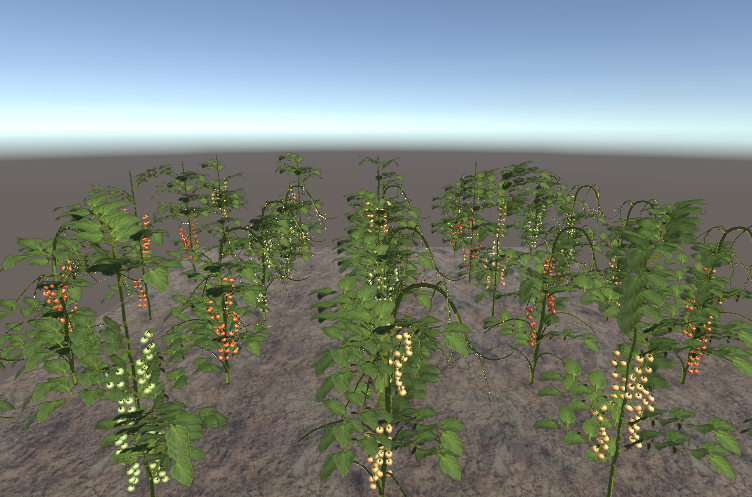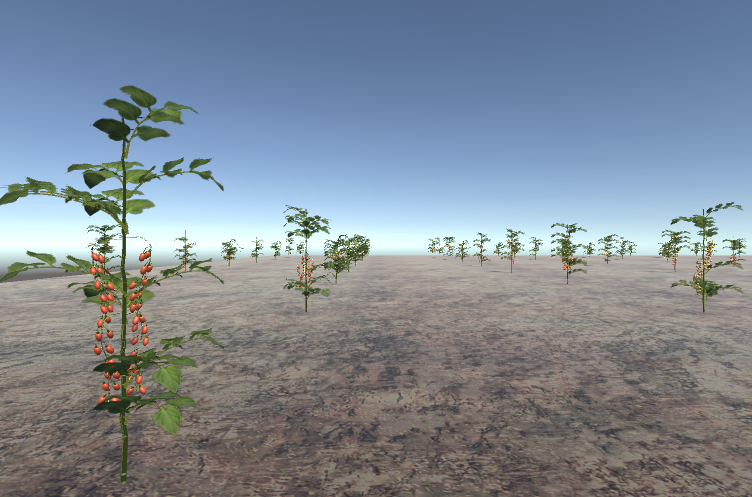This package is a tomato farm/glasshouse generator/simulator compatible with both Gazebo and Unity in ROS2 as part of the Agri-open Core (AOC) project. This repository consists of four key parts:
- Random tomato farm generator in Unity
- Random tomato glasshouse generator in Unity
- Random tomato glasshouse generator in Gazebo
- Simulator for the generated tomato farms in Unity and Gazebo
A group of tomato farm environments generated with these packages can be seen here.
If you use this project in your research or work, please cite the following paper:
@inproceedings{flores2024,
author = {Espejel Flores, Juan Pablo and Yilmaz, Abdurrahman and Soriano Avendaño, Luis Arturo and Cielniak, Grzegorz},
title = {Comparative Analysis of Unity and Gazebo Simulators for Digital Twins of Robotic Tomato Harvesting Scenarios},
booktitle = {submitted to Towards Autonomous Robotic Systems (TAROS 2024)},
year = {2024},
doi = {DOI}
}
Prepare a desktop PC with Ubuntu 22.04 and install the ROS2 Humble release.
Install Git:
sudo apt install gitClone the repository and build it
mkdir -p ${your_ws}/src
cd ${your_ws}/src
git clone --branch main git@github.com:LCAS/aoc_tomato_farm.git
git checkout main
cd ${your_ws} && colcon build
source install/setup.bashBefore generating Unity-ROS2 simulations, set the ROS 2 middleware and the localhost-only mode in the ~/.profile file (or in ~/.bash_profile or ~/.bash_login if either of those exists):
export ROS_LOCALHOST_ONLY=1
export RMW_IMPLEMENTATION=rmw_cyclonedds_cppRun Jupyter Notebook
cd ${your_ws}/src/aoc_tomato_farm/tomato_farm_generator/scripts/
jupyter notebook glass_house_generator.ipynbIn this file, the farm size, the number of rows, the number of plants in each row, the distance between each plant and each row, the number of greenhouses, and the attenuation of the lights can be adjusted parametrically. Each plant on the farm is generated randomly, including the locations of stems, leaves, fruits, and so on. The generated tomato farm models and world files, both compatible with Gazebo Sim and Gazebo Classic, are saved in the tomato_farm_generator/generated folder.
To use a generated tomato farm in simulation, copy the files in the tomato_farm_generator/generated folder into the tomato_farm_simulator/models and tomato_farm_simulator/worlds folders, and modify the launch file (tomato_farm_world.launch.py) accordingly.
Run the following launch file to simulate only the Gazebo tomato farm world:
ros2 launch tomato_farm_simulator tomato_farm_world.launch.pyIn the Gazebo Generator, the lighting condition of the lamps can be adjusted with the LIGHT_INTENSITY variable, as the value of this variable increases, the intensity of the light diminishes.
Go to Unity Download page and download Unity Hub. Once downloaded, install Unity 2022.3.17f1 via Unity Hub.
Open Unity Hub and navigate to the projects window. Click the "Add" button. Locate your aoc_tomato_farm/unity_tomato_farm_generator project and select it to add it to your Unity Hub and your Unity project will now be displayed in the projects list.
In this Unity project, various parameters such as the farm size, the number of rows, the number of plants in each row, the distance between each plant and each row, the number of glasshouses, and the intensity of the lights can be adjusted using a group of public variables. Each plant on the farm is generated randomly, including the locations of stems, leaves, fruits, and more.
Once customization of your environment has finished, you can see the previsualization of the world in the play mode (pushing the play button) and, finally, export. Before generating your Unity world, it is necessary to create a new folder in tomato_farm_simulator/worlds with the next format RowLenght+mx+NumberofRows+mU (8mx4mU, 7mx3mU, 2mx4mU).
To generate your simulation, go to the option file of the menu and select Build Settings... In build settings, select button build and save your project in the folder generated for this special environment with the format environment.x86_64.
To use a generated tomato farm in simulation, modify the launch file (unity_Launch.py) accordingly or open your environment directly.x86_64 file in tomato_farm_simulator/worlds/environment.x86_64 folder. In addition, you can stay in Unity's play mode all that you want before exporting your project, it is possible to test your project only using the play mode of Unity.
To switch between generating a tomato glasshouse and a tomato farm, change the value of the environment variable. Set environment to 0 to generate a tomato glasshouse, or set it to 1 to generate a tomato farm.
Please refer to the README of the ROS2 for Unity package for the setup of communication between the tomato environment and ROS2 and import the package into the asset folder of your unity_tomato_farm_generator. Once ROS2 for Unity is installed, one can modify the example scripts and associate them with the models to interact with their tomato farm environment.
Import models directly to the environment using URDF-Importer package.
In the Unity Generator, the lighting condition of the lamps can be adjusted with the Lamp Intensity variable. The range of values to generate acceptable light conditions is between 0 and 1, where small values correspond to lower light intensity. If you do not want to generate lights in your Unity environment, the value of Lamp Intensity must be 0.
To display both Unity and Gazebo environments, run the following launch file.
ros2 launch tomato_farm_simulator GazeboxUnity.launch.pyPS: Glasshouse outer glazing structure model in the simulations can be purchased from here. We couldn't share it here due to license restrictions.






